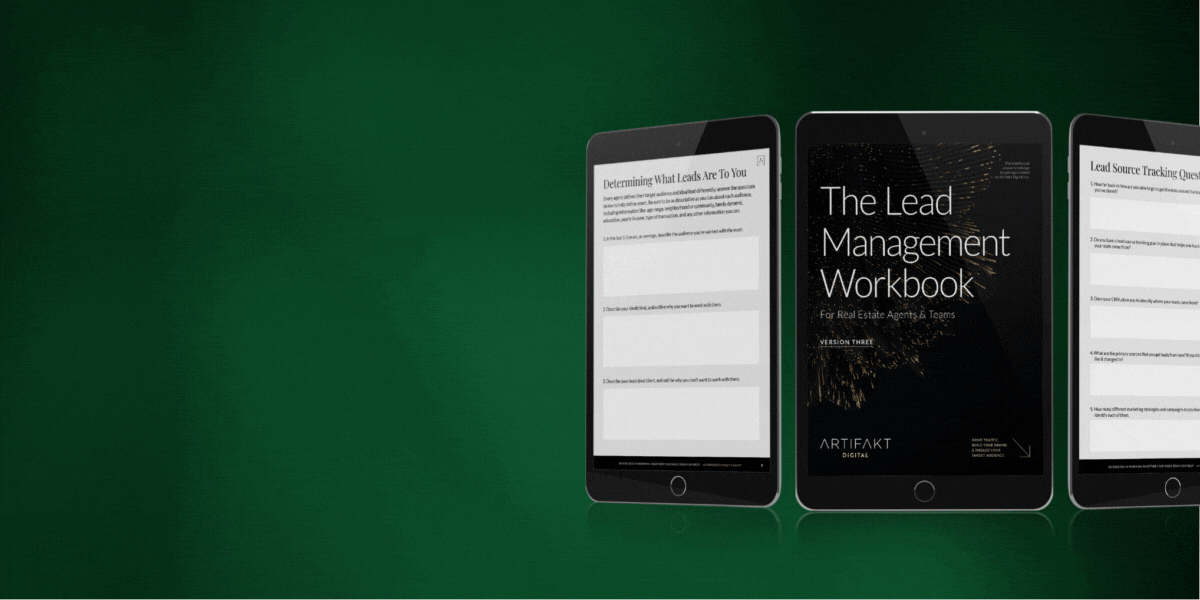It’s no surprise that if you ask a real estate agent what the goal of their marketing strategy is, they’ll tell you: generating more leads.
Generating leads is a big part of the reason we have marketing strategies at all. But, a lot of agents stop at lead generation and don’t have a plan in place for what to do with those leads once they get them, which means a lot of lost leads and a lot of lost business.
When an agent gets a lead, they’ll often need to decide if the lead is ‘good’. And if the person isn’t absolutely perfect and doesn’t want to transact immediately, the agent will often say the lead isn’t any good.
When someone fills out a form, sends a text, or leaves a voicemail, the average agent will respond once, and if they don’t get an answer, they’ll say: that lead isn’t good; but what do they mean by ‘good’ exactly?
Defining A ‘Good’ Lead
Any time that someone contacts you or interacts with your brand in any way, whether that’s:
- Filling out a home evaluation form on your website
- Calling you for information about a neighbor’s home that just sold
- Downloading a buyer’s or seller’s guide on your website
- Testing you to see if you can come by and appraise their home
- Or anything else…
They’re raising their hand and saying: “I’m interested in something that you have to offer”; but a lot of agents don’t really see those as leads. Or, at a minimum, they don’t know what to do with them. Some agents even see these types of leads as a hassle and a waste of time.
Remember, just because someone isn’t ready to transact right now, at this moment, it doesn’t mean they’ll never transact. When they do, you want them to think of you, your brand, and your business.
A good example of this is with a home evaluation inquiry. Many agents have done home evaluations for people, either digitally or in person, only to find that a year later they ended up listing and selling with another agent, and they often get upset by that.
That said, if the agent didn’t have any other plan in place to build rapport with that person, and they never contacted them again, is it any surprise they went with someone else that did? The bottom line is, there’s a lot of leads being left on the table that other agents will be more than happy to take.
To be successful as a real estate agent, we all know that we need to have a lead-generation strategy in place, which is part of your overall marketing strategy. There are 2 more keys to the process, though, that most agents forget about. That’s lead management and lead nurturing.
What is Lead Management?
Lead management is the process of how you sort, classify, and what you do with your leads that come in.
When it comes to sorting leads, you need to have buckets to sort them into. For an agent, there are a ton of ways to do this, but an obvious one would be:
- Wants to transact now
- Wants to transact in 6 months
- Wants to transact in 1 year or more
You’ll also want to sort whether these are buyer or seller leads and create buckets for each of them. How do you do that? There’s really a limitless number of ways, but in most cases, you’ll want to use your CRM and/or marketing applications.
In those applications, you’ll want to be able to flag these people so you can easily identify who fits in which bucket, because, you’ll want to be able to send them the right information at the right time, to build your lead nurturing strategy…
Much like a snowflake, no two leads are the same. They each have their own wants, needs, and conditions/circumstances affecting them. A timeline is a great place to start, but it helps to get more and more granular to better define one lead from another.
So, lead management introduces this all-important concept of the lead lifecycle. How we market to that lead, rather how we nurture it, is dependant on that lifecycle.
What is Lead Nurturing?
Lead nurturing is how you interact with those leads after you’ve sorted them into buckets, and it’s a complicated topic with a near endless list of options as to how you do it.
Lead nurturing is both a science and an art, and it’s a delicate balance between annoying and providing value.
Once you have an understanding of where a lead stands, the nurturing process begins. This could take the form of a drip campaign (a coordinated string of emails to guide a lead through a process), or it could be something as simple as reaching out to that lead with a guide to their transaction.
Basically, nurturing is further deepening your ties to any lead with your extended marketing materials. They’re already familiar with your brand, overall, and are interested in it. Now, you need to market to them based on that brand power and build a rock-solid connection.
Going back to our conversation around lead management, your nurturing process will most definitely differ. If someone is buying for the first time and looking to transact a year from now, a key part of your nurturing process may be easing them into buying altogether (perhaps with a guide to pre-approvals or tickets to a local home show).
On the other hand, if someone is selling immediately, a key feature of your nurturing may be packaging a free home evaluation with a marketing piece that breaks down how you’ve gotten other clients results in a similar market. Nurturing is versatile, it changes, and it puts the single lead at the center of your universe.
After all, isn’t that how a potential client is going to want to feel?
Lead management and lead nurturing makes a potential client feel like the only person in the room. You make them a priority, treat their specific needs, and endear your business directly to them.
Bringing it All Together
A lot of agents leave a lot of leads on the table just because they don’t think they’re ‘good’, but that also means leaving a lot of money on the table.
Most likely, these people will still want to transact; it might not be today, but they will at some point.
By recognizing that when these people interact with you they are raising their hands, getting them into your database, classifying them, and staying in contact with them through nurturing, they’re more likely to think of you and your brand when they are ready to transact.
When you make a lead feel like a priority, even a year away from transacting, they become familiar with and reliant on your brand before you even deal with them. The brand equity you build up is incalculable, and it’s all because you didn’t just generate a lead – you nurtured it.
Want to generate more sales by implementing a lead and client nurturing strategy? Download our Lead Nurturing Workbook. It’s a self-guided, interactive workbook where you answer questions about how you attract, handle, and market to your incoming leads, and put together a plan to implement a solid lead nurturing strategy that gets results. And, it’s free to download.




